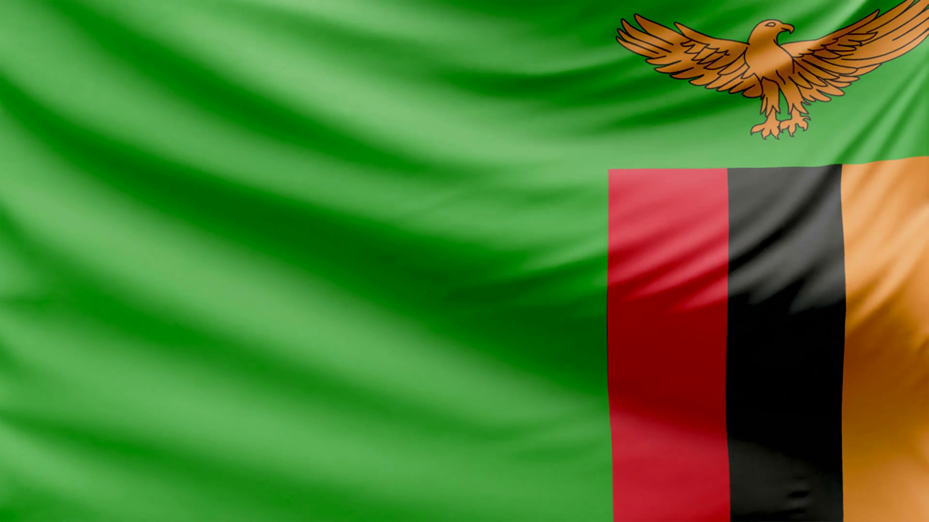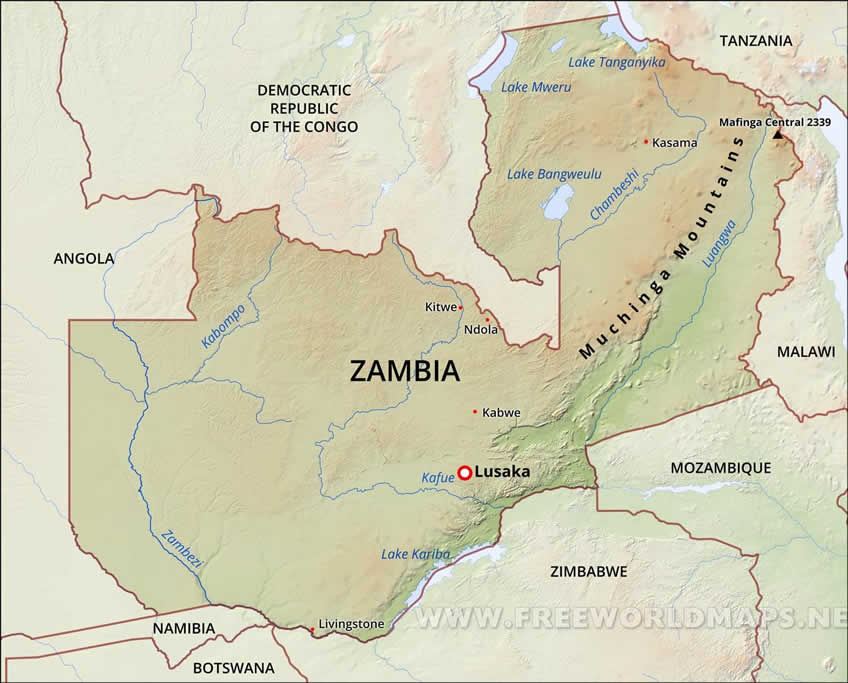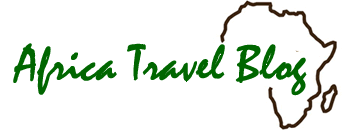Zambia is a landlocked southern African nation situated to the east of Angola and to the north of Zimbabwe. A resource rich nation, Zambia is one of the leading producers of copper on the African continent. The country is a former British colony and attained its independence on the 24th of October 1964 when Northern Rhodesia seceded from the Rhodesia colony.
Zambia was a prominent supporter of the Africa National Congress (ANC) an anti-apartheid movement in South Africa. The country provided a refuge for members of the ANC and the party’s headquarters were based in the Zambian capital Lusaka during the 1970s.
Administration:
Lusaka is the administrative capital of Zambia. The country is divided into nine provinces; Central, Copperbelt, Eastern, Luapula, Lusaka, Northern, North-Western, Southern, Western. Each province is governed by a deputy minister appointed by the country’s president. The provinces are further divided into districts.
People of Zambia:
Zambia has an estimated population of 11, 502, 010 people. The country’s population is mostly African consisting mainly of; Tonga, Lunda, Luvale, Kaonde, Nkoya, Lozi, Bemba and Nyanja-Chewa. There is also a small European and Asian population concentrated mainly in Lusaka. Christianity is the main religion though Islam and Hindu are widely practiced. English is the official language of Zambia and other widely spoken vernaculars are; Bemba, Kaonda, Lozi, Lunda, Luvale, Nynaja and Tonga.
Zambia Health:
Zambia with an estimated population of 11.5 million has over 900,000 people living with HIV/AIDS. It is estimated that the condition kills more than 80,000 people each year. HIV/AIDS is one of the main health challenges facing the people of Zambia. The condition has greatly reduced life expectancy in the country.
Other health problems in the country are associated with poor food and water hygiene. There is also a high risk of developing malaria in some parts of the country.
Hospitals: the large towns and cities including Lusaka, Luanshya, Choma, Kabwe, Kitwe, Chipata, Livingstone, Mazabuka and Ndola have hospitals or health centers. Pharmacies can also be found in most towns.
Emergency phone numbers in Zambia: for police, ambulance or fire emergencies, you can call the 999 number for assistance.
Zambia Currency:
The Zambian currency is known as the Zambian Kwacha (ZMK). The currency was introduced in 1968 to replace the pound which had been used since independence in 1964 and was adopted from the Rhodesia and Nyasaland pound used during the colonial period here. One Kwacha is equal to 100 Ngwee.
Denominations: coins exist for 25 and 50 Ngwee and 1, 5 and 10 Kwacha. Notes exist for 20, 50, 100, 500, 1000, 5000, 10000, 20000 and 50000 Kwacha.
Exchange Rates:
A number of banks in major towns in the country offer foreign exchange services for the Kwacha against major world currencies. There are also a number of foreign exchange bureaus, many in Lusaka and also at the international airport here.
At the time of writing (July 2006); One $US was equal to 3350 ZMK, One British Pound was equal to 6173.43 ZMK and One Euro was equal to 4280.78 ZMK.
Zambia Facts & Figures:
– Location: Southern Africa, north of Zimbabwe, east of Angola.
– Capital City: Lusaka.
– Population: 11, 502, 010.
– Other major towns and cities: Kabwe, Ndola, Livingstone, Mongu, Mpulungu, Chipata.
– Religion: Christian, Islam, Hindu, Others.
– Languages: English is the official language; the main vernaculars spoken are Bemba, Kaonda, Lozi, Lunda, Luvale, Nyanja and Tonga.
– Currency: Zambian Kwacha (ZMK).
Zambia Public Holidays:
January
-New Years Day on the 1st of January
March
-Youth Day on the 12th of March
May
-Labor Day on the 1st of May
-African Freedom Day on the 25th of May
July
-Heroes’ Day on the 3rd of July
-Unity Day on the 5th of July
October
-Independence Day on the 24th of October
December
-Christmas Day on the 25th of December
-Boxing Day on 26th of December
Other holidays (dates vary each year): Farmers’ Day, Easter, Good Friday.
Zambia Flag:

The present Zambian flag was adopted on the 24th of October 1964 at the same time that the country attained its independence from the United Kingdom.
Green is for the fertile agricultural lands, red signifies the struggle for independence, black is for the people of Zambia and the orange color is for the mineral wealth.
Map of Zambia:

People of Zambia:
Zambia has an estimated population of 11, 502, 010 people. The country’s population is mostly African consisting mainly of; Tonga, Lunda, Luvale, Kaonde, Nkoya, Lozi, Bemba and Nyanja-Chewa. There is also a small European and Asian population concentrated mainly in Lusaka.
Christianity is the main religion though Islam and Hindu are widely practiced.
English is the official language of Zambia and is well-spoken by many Zambians particularly in urban areas and visitors rarely have problems communicating. Other widely spoken vernaculars are; Bemba, Kaonda, Lozi, Lunda, Luvale, Nynaja and Tonga.
Media in Zambia:
The once heavily controlled media sector in Zambia is at present enjoying high levels of autonomy. The Zambian government has over the last decade passed laws to allow for private media houses to operate in this once government domain.
There are nine television broadcast stations in the country; these are either foreign or run by the ZNBC (Zambia National Broadcasting Corporation) a government owned company. The corporation also operates a number of radio stations. Popular radio stations in Zambia are;Radio Christian Voice, Radio Phoenix, Radio Icengelo, Radio Yatsani, Q-FM and Radio Choice.
Newspapers in Zambia:
Leading daily newspapers printed in English are; The Times of Zambia, The Post, The Zambia Daily Mail, The National Mirror, The Monitor.
Sports in Zambia:
Popular sports in Zambia include; soccer, basketball, volleyball, martial art disciplines and in recent years; cricket and rugby. Zambia also regularly sends teams to the Commonwealth and Olympic Games.
Soccer in Zambia:
Soccer is the most popular sport in Zambia. The country has managed to produce a number of quality players who are currently plying their trade in professional leagues around the world. Leading clubs include; the Kabwe Warriors, Lusaka Dynamos, Power Dynamos, Nakambala Leopards, Zanaco FC and Konkola Blades.
The national team is one of the prominent in the southern-African region. The team known as “Chipolopolo” won the COSAFA regional cup in 1997 and 1998. Zambia has also participated at the finals of the Africa Nations Cup twelve times and were losing finalists at the 1974 and 1994 finals. Sadly one of the most notable events in Zambian sport is the air disaster of 1993 when the plane carrying the national squad crashed off the coast of Gabon enroute to Senegal for a World Cup Qualifier.
Tourism in Zambia:
Zambia is home to a developing tourism industry. A landlocked nation, the country offers some of the most scenic game reserves and parks which are home to healthy wildlife populations. The country has a decent transport infrastructure and charter flights are available from Lusaka to a number of tourist hotspots. Zambian Airlines also runs regular scheduled flights from Lusaka to a number of towns. The promotion of the country as a tourist destination in the region is handled mainly by the Zambia National Tourist Board.
Accommodation: in cities such as Lusaka you can find a number of good hotels. Lodges and campsites offer accommodation for visitors to game parks and reserves.
Zambia offers the breathtaking Victoria Falls on the River Zambezi. Here one can either indulge in a variety of recreational activities and extreme sports including gliding, rafting, canoeing, fishing or bungee jumping. The shores of the Zambezi are home to hundreds of bird species making it popular for bird watching and sightseeing. The river has large populations of hippos and crocodiles; and other wildlife regularly come here for a drink.
Game parks and reserves: Zambia’s premier park is the Kafue National Park which is the largest game park in Africa. The park is traversed by the Kafue River and is home to large wildlife and bird populations. Other parks in Zambia are; Luambe National Park, Sumbu National Park, Lavushi Manda National Park, Lochinbar National Park, Lower Zambezi National Park and South Luangwa National Park.
Game Parks in Zambia:
Zambia is home to a number of established game parks and reserves. These form the backbone of the country’s developing tourism industry and with deteriorating conditions in neighboring Zimbabwe, many visitors to the region have chosen to venture here. The country’s parks are blessed with a rich array of wildlife, vegetation and hundreds of bird species living in their natural habitats. As a result Zambia is quickly becoming a popular safari destination.
Kafue National Park:
Situated about 60 km from the Zambian Capital Lusaka, Kafue National Park is Zambia’s premier game reserve home to a large concentration of wildlife. The park covers an area of 22, 400 km square and is one of the largest game reserves in the world and the largest on the African continent. The Kafue River which is a key tributary of the Zambezi traverses the park and is home to a number of animals and bird species.
Lower Zambezi National Park:
Covering an area of 4,092 km square, the Lower Zambezi National Park encompasses part of the Zambezi River in Zambia and is the newest park in the country. As such it is still underdeveloped with very few roads and many areas of the park are not accessible by car.
Other key game parks in Zambia are; Luambe National Park, Sumbu National Park, Lavushi Manda National Park, Lochinbar National Park and South Luangwa National Park.
Kafue National Park:
Situated about 60 km from the Zambian Capital Lusaka, Kafue National Park is Zambia’s premier game reserve home to a large concentration of wildlife. The park covers an area of 22, 400 km square and is one of the largest game reserves in the world and the largest on the African continent. The Kafue River which is a key tributary of the Zambezi traverses the park and is home to a number of animals and bird species.
The park was established in 1950. The park can be reached by road from Lusaka and other parts of the country. The park is also served by a number of airstrips and charter flights can be boarded from Lusaka. Accommodation is available at a number of campsites within the park and can be prearranged by your travel agent.
Wildlife at Kafue:
Kafue is popular for wildlife viewing and bird watching (over 350 species have been noted). Visitors to the park are rarely disappointed. Here you will find; hippo, lion, sable antelope, roan antelope, elephant, crocodile, cheetah, leopard, civet and jackal.
Lower Zambezi National Park:
Covering an area of 4,092 km square, the Lower Zambezi National Park encompasses part of the Zambezi River in Zambia and is the newest park in the country. As such it is still underdeveloped with very few roads and many areas of the park are not accessible by car. The wildlife population here is not as extensive as in other Zambian parks though the main attraction is the natural unhampered vegetation and state of “wilderness”.
The park also offers opportunities to view wildlife up-close while traveling along the river, its streams or on foot. For accommodation, there are a number of good lodges and camps within the park.
Wildlife: animals at the park include; crocodile, hippo, elephant, leopard, lion, hyena, impala, zebra, waterbuck, kudu, warthog, leopard and fish eagle.
Zambia Hotels:
There are a number of good hotels in Zambia. The best hotels in the country can be found in the Capital; Lusaka and other major towns such as Livingstone and Ndola. The country also offers a good selection of accommodation options including a number of excellent tented camps and lodges which cater for visitors to game parks and reserves. Popular hotels in Zambia include:
InterContinental Lusaka: one of the leading hotels in the city, the hotel is a member of the InterContinental Group of Hotels. The hotel is situated on Haile Selassie Avenue near the city centre and offers a good selection of amenities and services such as; conference rooms, health and fitness centre, restaurants, bars, internet access, swimming pool, business services, information desk, car hire, foreign exchange.
Taj Pamodzi Hotel: situated at Church Road a short distance from the Lusaka City Centre, the Taj Pamodzi is one of the city’s premier hotels and a five star establishment. The hotel offers one of the most comprehensive lists of amenities and services in Lusaka such as; business and conferencing facilities, high speed internet, hair and beauty salon, foreign exchange, laundry, car rental, café, restaurant, bar, spa, health and fitness centre, swimming pool and shops.
Flights to Zambia:
There are a number of airlines that offer regular scheduled flights to Zambia. The country is served by two international flights; the Livingstone International Airport and Lusaka International Airport. The Lusaka Airport is the busier of the two and handles the bulk of domestic and international flights in Zambia.
The airport is also home to Zambian Airways which flies regularly to and from Johannesburg and Harare. The airline also flies regularly to a number of towns and tourist locations in the country.
Other passenger airlines flying regularly to Zambia are; Nationwide Airlines, Kenya Airways, Air Malawi, Ethiopian Airlines, Air Zimbabwe.
Zambian Airways:
Zambian Airways is the national airline of Zambia and flies regularly to a number of domestic and regional destinations from its main hub at the Lusaka International Airport.
The airline’s scheduled destinations are; Lusaka, Mfuwe, Livingstone, Lower Zambezi, Ndola, Chipata, Harare and Johannesburg. For more information on the airline including news and information on the frequent flyer program, you can visit its website at: http://www.zambianairways.com/
Zambia Visa:
Nationals of most commonwealth nations except; Australia, Britain, Bangladesh, Canada, Gambia, Ghana, Nigeria, India, Mozambique, Sri Lanka, Sierra Leone, Pakistan and Papua New Guinea require visas to enter Zambia.
Nationals from a number of African countries can obtain a visa at entry points to Zambia. You should however confirm this with your nearest consulate or travel agency as requirements change from time to time.
The country has high commissions and consulates in a number of commonwealth member countries.
There are Zambian Embassies in a number of European Nations including; Germany, the UK and Sweden. There is also an Embassy in the United States.
For up-to-date visa requirements, conditions and application, you can consult your nearest consulate, or get assistance from your travel agent.
You may also require an entry visa if you intend to travel to other African countries from Zambia.
Consular Services
Embassy Directory:
Zambia Embassies and Consulates in Asia:
The Zambian Embassy in China
No 5 Dong Si Jie, San Li Tun
Tel: 010 6532 1554/ 6532 1778
Fax: 010 6532 1891
The Zambian Embassy in India
110057 F-8/22 Vasant Vihar,
New Delhi, India
Tel: 91 11 6847 681/ 6846 848
Fax: 91 11 6147 928
The Zambian Embassy in Japan
10-2 Ebara 1-Chome, Shinagwa-Ku
Tokyo 142, Japan
Tel: 81 3 3491 0121
Fax: 81 3 3491 0123
Zambia Embassies and Consulates in Europe:
Zambian Embassy in Belgium
469 Avenue Moliere
1060 Brussels, Belgium
Tel: 32 2 343 5649
Fax: 32 2 347 4333
Zambian Embassy in Germany
Axel-Springer-Strabe 54a
10117 Berlin, Germany
Tel: 49 30 206 29 40
Fax: 49 30 206 29 419
Zambian Embassy in Sweden
Engelbrektsgatan 7
Box 26013, Stockholm, Sweden
Tel: 46 8 799 040
Fax: 46 8 796 850
Zambian High Commission in the United Kingdom
2 Palace Gate, Kensington,
London W8 5NG
Tel: 44 207 589 6655
Fax: 44 207 581 1353
Zambia Embassies and Consulates in North America:
Zambian Embassy in the United States
2419 Massachusetts Avenue,
NW, Washington DC 20008
Tel: 1 202 265 9717
Fax: 1 202 332 0826

